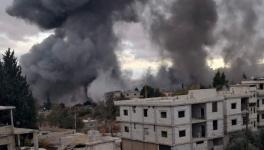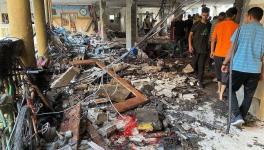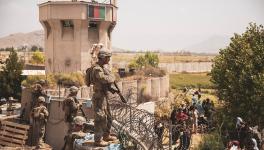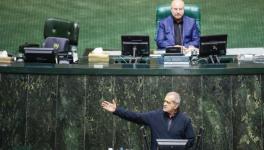Post-Bakhmut Scenario in Ukraine War
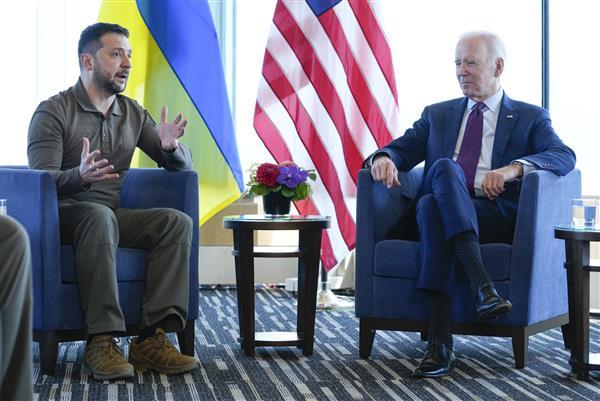
Ukraine President Vladimir Zelensky (L) met US President Joe Biden at Hiroshima, Japan, on May 21, 2023
Ukraine President Volodymyr Zelensky and US President Joe Biden met on the sidelines of the G7 Summit at Hiroshima within hours of the statement from the Kremlin at 1 a.m last Sunday, transmitting President Vladimir Putin’s greetings to the Russian forces for the “completion of the operation to liberate Artemovsk” (known as Bakhmut in Ukraine.)
The operation lasted 224 days and turned into an epic battle. Ukraine paid a heavy price in blood in trying to hold onto Bakhmut, which came to be called a “Meat Grinder”. American analysts have listed 25 Ukrainian brigades and at least 9 battalions and 5 regiments — an estimated deployment of 120,000 troops at the very least — thrown into the battle by Kiev. An estimated 70% casualties would mean that Ukraine suffered over 70,000 killed and wounded. It is a devastating defeat.
Conventional military doctrine says that an army attacking an entrenched force will need at least three times more soldiers than the defending force in fortifications. But Wagner fighters numbering 32,000 fighters faced off with a NATO proxy force almost 4 times bigger in numbers and equipped with modern weaponry.
The shock over the crushing defeat was writ large on the faces of US President Biden and Ukrainian President Zelensky as they faced the media at Hiroshima a few hours after the Kremlin statement appeared. Reading from a prepared text, Biden announced, in a major reversal of policy, that the US would be “launching some new joint efforts with our partners to train Ukrainian pilots on a fourth-generation fighter aircraft like the F-16.”
Meanwhile, in a series of showy incidents, Ukraine began hitting targets in Russia with US and British supplied weapons. There have been sporadic artillery and Himars missile attacks on Russian civilians in border towns; two drone attacks on the Kremlin; and British Storm Shadow cruise missile strikes on targets in Russia. In one particular instance last week, there has been a cross border incursion in the Belgorod region with US supplied vehicles and weapons. But none of these attacks can be deemed as “game changers.”
While the US and the rest of NATO are feigning ignorance about these attacks, the key fact is that Ukraine gets targeting data that only NATO intelligence sources could provide. Thus, the decades-old red line dating back to Cold War has been breached — namely, that neither the US nor Russia would attack the other side’s territory directly or indirectly. (They held the guardrails even during the Afghan jihad in the 1980s.)
There is going to be consequences. The first sign of it came with the news that nuclear weapons are already being deployed in Belarus and Defence Minister Sergey Shoigu was in Minsk to sign the necessary agreement detailing the logistics of deployment. Biden told reporters on Friday after returning from Japan that his reaction to the Russian deployment is “extremely negative.”
But in reality, Moscow’s intention is to provide Belarus with deterrent capability against any rash moves by NATO such as cutting off access to Kaliningrad. Incidentally, the US too has been keeping nuclear weapons on European soil for many years.
But a flashpoint can always arise. The upcoming NATO exercise codenamed Air Defender 23 (June 12-23) will be the most significant military exercise ever carried out over the European skies and the most extensive deployment exercise of air forces in the history of the western alliance — involving 25 NATO countries, 10,000 military personnel and approximately 220 aircraft.
To quote Larry Johnson, well-known American blogger and former analyst at the CIA, “a training operation of this size and scale against the backdrop of heightened tensions in the region is akin to lighting a match in a gasoline storage tank.” That said, at the tactical level, Russian military is also positioning itself for further operations to complete the liberation of Donbass, after having gained control of Bakhmut, which is a major communication hub through which all Ukrainian logistics passed along the Donetsk arc up to Seversk so far.
A report in Izvestia on Wednesday said quoting expert opinion that Avdiivka and Maryinka are “next in line… so that there will be no shelling of Donetsk city… Next, we will have to turn off the big Donetsk arc — from Ugledar to Seversk with access to Konstantinovka and Slavyansk. These are the last two cities of the large Donbass agglomeration, followed by the steppe (leading toward Dnieper River) where it will be very difficult for the enemy to hold on.”
Again, the Wagner fighters are being replaced by regular Russian forces for further operations. Kremlin Spokesman Dmitry Peskov said in an interview on Russian TV on Friday: “It’s hard to say where the breaking point is… Obviously, the degree of direct and indirect involvement in this conflict by the countries of the collective West is surging day by day. This may protract the conflict, but will not turn the tide drastically. It cannot turn the tide at all. Russia will press on with the operation, and Russia will ensure its interests one way or another and achieve the designated objectives.”
Meanwhile, Russia has been conducting an intensive bombing campaign to make it difficult for Kiev to assemble the manpower and firepower required to launch and sustain an offensive operation beyond a few days, and is intensifying its operations overall to decimate Ukraine’s military capabilities.
The “known unknown” is how the 2024 US election campaign will affect the trajectory of the war. Biden’s shift on F-16 can be seen as a knee-jerk reaction. Even Gen. Mark Milley, chairman, Joint Chiefs of Staff admits that F-16 isn’t a “magic weapon.”
Meanwhile, Russia continues to probe the US intentions. In an interview with the prestigious International Affairs magazine, Russian Deputy Defence Minister Sergey Ryabkov said on Friday that “The US ruling elite has consolidated itself to a great extent on an anti-Russian basis, regardless of party affiliation. In my opinion, the situation is turning into a force majeure.”
However, Ryabkov who is the highest ranking “point person” for relations with the US at the foreign ministry, also added, “No matter how things turn out, we are willing to maintain dialogue with whoever comes to power (in the US), stays in power.”
Therefore, Ukraine relinquishing the accession to NATO and the EU and returning to neutral non-aligned status will remain one of the key conditions of a successful peace process in Ukraine. The big question is how far the NATO will go at its forthcoming summit in July in Vilnius; or, would this mean Ukraine’s full membership or something else? The likelihood of any big decisions in Vilnius can, perhaps, be discounted.
Interestingly, the Kremlin instinctively warmed up to the idea of a phone call to Putin “in due course,” voiced by German Chancellor Olaf Scholz soon after his return to Berlin from the G7 summit in Hiroshima. Berlin has consistently disfavoured any precipitate move by NATO apropos Ukraine’s membership.
In an interview with Wall Street Journal on Friday celebrating his centennial, Henry Kissinger also remarked that “the offer to put Ukraine into NATO was a grave mistake and led to this war.” Kissinger advocated instead greater clarity in Russia’s stance on Europe, flagging that while Russia is interested in fostering ties with Europe for its own development, it is also cautious of potential threats coming from the West.
MK Bhadrakumar is a former diplomat. He was India’s ambassador to Uzbekistan and Turkey. The views are personal.
Get the latest reports & analysis with people's perspective on Protests, movements & deep analytical videos, discussions of the current affairs in your Telegram app. Subscribe to NewsClick's Telegram channel & get Real-Time updates on stories, as they get published on our website.










